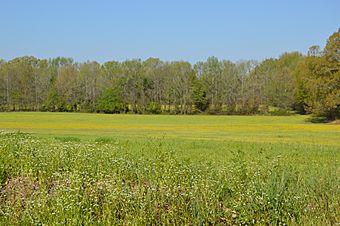Siege and Battle of Corinth Sites facts for kids
|
Siege and Battle of Corinth
|
|

Union field fortifications along Harper Road, north of Corinth
|
|
| Nearest city | Corinth, Mississippi |
|---|---|
| NRHP reference No. | 91001050 |
Quick facts for kids Significant dates |
|
| Added to NRHP | May 6, 1991 |
| Designated NHLD | May 6, 1991 |
The Siege and Battle of Corinth Sites are a special area in the United States. This area is called a National Historic Landmark District. It protects important places from three big battles during the American Civil War. These battles happened in and near Corinth, Mississippi.
The sites include parts of the Siege of Corinth (from April 29 to June 10, 1862). They also include places from the Second Battle of Corinth (October 3-4, 1862). A smaller battle, the Battle of Hatchie's Bridge on October 5, 1862, is also included. These important places are in both Alcorn County, Mississippi and Hardeman County, Tennessee. Some parts are even protected inside Shiloh National Military Park. The whole area became a landmark in 1991.
Contents
Why Corinth Was Important
Corinth started as a railroad town in the 1850s. It grew up around a very important spot. This was where the Memphis and Charleston Railroad met the Mobile and Ohio Railroad. The Memphis and Charleston line opened in 1857. The Mobile and Ohio line opened in 1861.
This railroad crossing made Corinth a key place for trade in the southern United States. When the American Civil War began, it became super important for the military. Armies needed to control these railroads to move soldiers and supplies.
The Battles for Corinth
After a tough battle at Shiloh in April 1862, Confederate soldiers moved back to Corinth. They built strong defenses there. These defenses included earthworks, which are walls made of dirt. They wanted to protect the vital railroad lines.
The Siege of Corinth (1862)
Union forces then surrounded Corinth. This long period of surrounding a city is called a "siege." It lasted for about a month. The Union army slowly pushed the Confederates back. In the end, the Confederate soldiers had to leave Corinth.
The Second Battle of Corinth (1862)
Later that year, Confederate soldiers tried to take Corinth back. This led to the Second Battle of Corinth. They attacked the Union forces who were now holding the city. But the Union army fought them off. The Confederates lost many soldiers in this battle.
The Battle of Hatchie's Bridge
As the Confederate soldiers retreated from Corinth, they were attacked again. This happened at the Battle of Hatchie's Bridge. This battle was near Pocahontas, Tennessee. Union soldiers were on their way to help the troops in Corinth. They met the retreating Confederates there.
What You Can See Today
The landmark district includes many different places connected to these battles. Most of them are in or near Corinth. You can see old earthworks and rifle pits. These were defensive walls and trenches built by both sides. The Confederates built them before the siege. The Union army built more after they captured the city.
A few buildings where military leaders stayed are also part of the district. The actual railroad crossing, which was so important, is also protected. These sites help us understand the history of the Civil War. They show us where important events happened.




